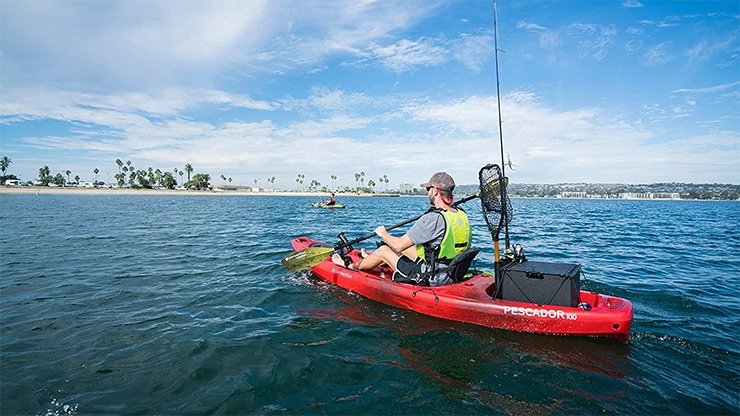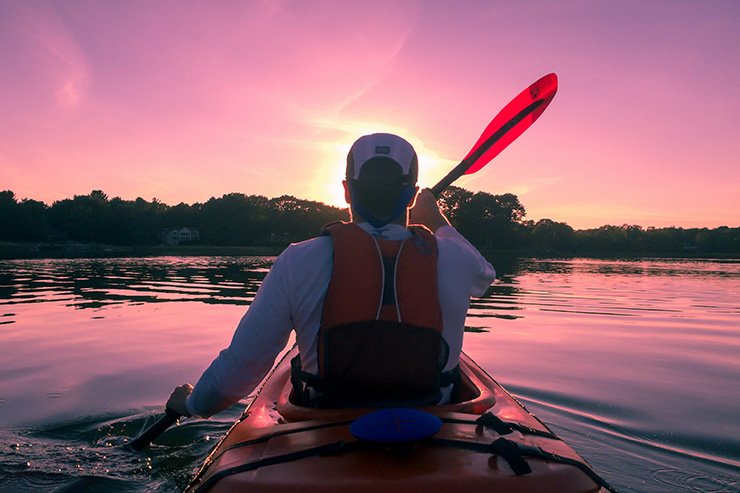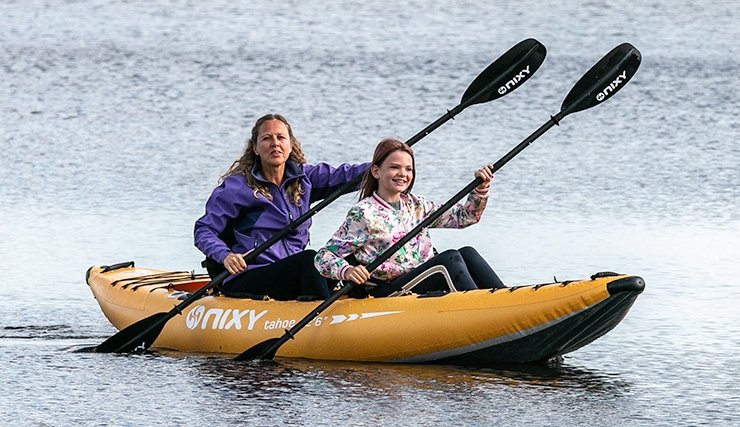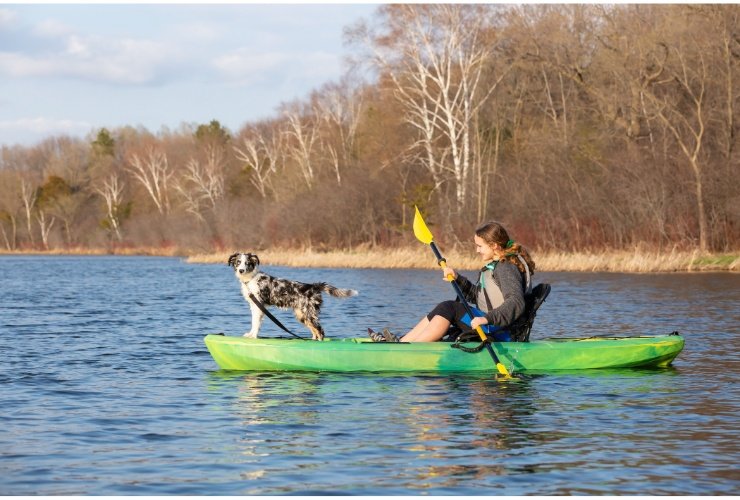Kayaking, for many people, means tranquility and freedom. You can escape to a world of your own for a few hours, a full day, or multiple days. Depending on where you’ll be paddling, you may not even have to interact with anyone other than your kayaking partner.
But while many people don’t know this, there are kayaking rules and regulations that you need to follow. They are there for your safety and that of other water users. Failure to follow these regulations could land you in trouble with the law.
So before you go on your next kayaking trip, take some time to familiarize yourself with these rules. I discuss them in depth here.
Key Takeaways
- It’s important to know the specific kayaking rules and regulations that apply in your state or any state you plan to visit.
- You are required to have a USCG-approved life jacket for everyone on board your kayak. Children have to wear theirs.
- Boating under the influence is illegal. Some states exempt kayaks from this law while others don’t.
- Be considerate of the environment and fellow water users. Offer assistance if you encounter someone in distress.
- If you have any questions or concerns about kayaking laws in a specific state, seek legal advice. It’s better to be informed.
Kayaking Laws and Regulations That You Need to Know
There are many federal boating rules and regulations that apply to kayaks. On top of that, every state has its own rules regarding recreational boating. And some of those apply to kayakers.
This article is intended for informational purposes and should not be interpreted as legal advice. At the end of the day, you need to go through your state’s boating and fishing laws and ensure you understand them. If you need clarification, consult an attorney.
Boating Under the Influence

Everyone knows about driving under the influence, but did you know that boating under the influence is a thing too? It is illegal to operate a boat while drunk in all 50 states (in some states, kayaks are exempt). The penalty varies from state to state.
In the state of Washington, for instance, it’s a gross misdemeanor that is punishable by up to a year in jail or up to a $5,000 fine. This applies if your blood alcohol content is over .08.
In Florida, it’s a second-degree misdemeanor that can attract a sentence of up to six months in jail or a fine of $500 to $1,000.
In Texas, you face up to six months in jail or a fine of up to $2,000 if caught kayaking with a blood alcohol content of 0.08% or more.
So, yes, you can get a DUI on a kayak – it’s called a BUI (Boating Under Influence).
Make sure you research your state’s specific laws because the details can vary. Although kayaks and canoes may be exempt in some states, kayaking while intoxicated is a bad idea.
Alcohol affects your vision and your judgment. When in the water, you should be able to make quick decisions when necessary. You may also find yourself dealing with unexpected problems like rough water and bad weather. These are not situations that you want to deal with while drunk.
According to the 2022 USCG Boating Statistics, alcohol is one of the top 10 contributors to boating accidents. So whether it’s illegal or not where you live, you shouldn’t drink and kayak.
Kayak Transportation Laws

Like BUI laws, rules concerning a kayak’s transportation vary from state to state. But many states follow the federal regulations.
Some states require a red flag if you have a long load overhanging. This cautions any driver approaching you from behind. There are also rules regarding how far a load can extend from your vehicle.
These rules are essential if you intend to transport your kayak on your vehicle. Depending on the size of your kayak, how you secure it, and the size of your vehicle, you can find yourself in trouble with local authorities. Besides, a kayak on a car, if not properly secured, is a danger to you and other drivers on the road.
Under federal regulations, a load can overhang by three feet at the front, four at the back, and four inches by the sides on a truck.
In the state of California, a load can overhang your vehicle by three feet at the front, four at the rear, and four inches on the sides if it extends more than that, you need to mark your cargo. You can use a red or fluorescent orange flag during the day and red lights at night.
In addition to this, be sure to get a good, sturdy roof rack when transporting your kayak on the roof of your vehicle. Have strong straps as well to tie the kayak down.
PFD Laws

Every kayak knows that a life jacket is a key safety accessory. But there’s always an excuse not to wear or bring one–it’s too hot, the water is calm, you’re not paddling too far out, etc.
To meet the United States Coast Guard requirements, you must have a personal flotation device for everyone onboard. Federal law requires all children under the age of 13 to wear a life jacket on recreational vessels. The life vest must be United States Coast Guard-approved too.
In addition to that, states also have their own PFD laws. In Alabama, for instance, anyone under 8 years old must wear a PFD. This age is lower than the USCG requires. But you need to know that federal law precedes state laws.
In Colorado, the people required to wear a personal flotation device are children under 13 years and anyone riding on personal watercraft. Check out the different state PFD laws to know what the rules and regulations in your state are.
Again, even though you aren’t required to wear a life jacket while kayaking, it’s strongly advised that you wear it at all times.
Drowning is the leading cause of death in recreational boating. In 2022 445 people died due to drowning, which accounts for about 75% of all recreational boating deaths in that year.
83% of those who drowned were not wearing a life jacket. Even with the other top causes of death like trauma and cardiac arrest, the number of victims who didn’t have a life jacket on was higher than those who did.
So it’s very much safe to say that a personal flotation device can and might save your life. Don’t just have a life jacket on board to meet requirements, make sure you wear it too.
Kayak Registration Rules

When talking about boat registration laws, many people don’t think they apply to kayaks. However, some states may require you to register your kayak if you intend to use it on public waters.
Some states only require registration for motorized vessels, others will require you to also register your paddle craft. In some states, even an inflatable kayak has to be registered!
In Alaska, for instance, you don’t have to register your kayak or canoe–unless it has an auxiliary powered unit. This means it must be registered if you use a trolling motor on your kayak. Washington State has similar rules and regulations. If your kayak is strictly human-powered, then it’s exempt.
The state of Ohio has stricter rules. Every recreational boat has to be registered, including kayaks, canoes, and inflatable boats. You have to renew the registration every three years too.
New York also requires the registration of all watercraft with a motor, regardless of how small the motor or craft is. Registration is done with the DMV.
In Minnesota, you must register all motorized watercraft, including motorized kayaks. If your non-motorized kayak is over 10 feet long, you’ll also have to register it.
Some states don’t require you to register your kayak if you’re from a different state that doesn’t require licensing. But there’s a duration limit. It’s essential to know and understand the details of regulations in your state or the state you’ll be visiting.
Many factors may exempt your kayak from registration, such as length and whether or not you have a motor. However, you shouldn’t assume.
Rules on Reckless Operation
As mentioned, kayaking rules and regulations are there to protect you and other water users. So, in addition to registration and wearing a PFD, the federal government and some states also have negligent operation rules.
Under federal law, operating a vessel recklessly in a way that endangers a person’s property, life, or limb is a class A misdemeanor. Violating the negligent operation rule can attract a fine of up to $5,000 for a recreational vessel.
In the state of California, several actions constitute negligence. These include but are not limited to harassing wildlife with your watercraft and operating in a manner that causes your vessel to collide with another person, watercraft, or object.
When operating your kayak, especially with a motor, you must be careful, especially in congested waters.
Kayak Fishing Laws

Kayak fishing is a popular kayaking discipline nationwide, as is fishing in general.
Fishing laws are implemented to prevent overfishing, protect fish habitats, rebuild overfished stocks, and ensure a sustainable seafood supply. The federal government has its regulations, and so do the different states–all of which you must adhere to.
First, you need a fishing license unless you’re fishing on private property–as long as you have permission from the owner if it’s not your property.
Some states make exemptions. In Texas, those born before January 1 1931, and kids under 17 years don’t need a fishing license.
In Florida, those who don’t require a license include children under 16 years and residents over the age of 65.
Second, you must know which fish you can and can’t catch. Some fish species are illegal, mainly because they’re endangered. Know the seasons as well because not all species are open all year round, and be sure of the bag limit too.
In Texas, for instance, killing, taking, or disturbing endangered fish species like the shovel-nosed sturgeon is illegal. The state also dictates that the waste of fish is illegal. This means you can’t leave edible fish taken from public waters to die if you don’t intend to consume it or use it as bait. You also can’t use game fish as bait.
In the state of Iowa, residents and non-residents under 16 years old don’t need a license, but they might be required to pay a trout fee.
Fishing regulations are constantly changing, and you must keep up if you don’t want to end up in legal problems.
Good Samaritan Laws
If you see another kayaker or boater in trouble, you’ll most likely want to hurry and help in any way you can. After all, you’d want anyone to do the same if you were in trouble. But as simple as such an act may seem, rules and risks are involved.
You are required to offer assistance to someone in danger at sea as long as you can do so without causing severe or further harm. Failure to do that can attract a fine of up to $1000 or a two-year jail term. There’s a debate about what constitutes “at sea” and what vessels are included here.
Under Rule 1 in the US Coast Guard Navigation Rules, it states that “These Rules shall apply to all vessels upon the high seas and in all waters connected therewith navigable by seagoing vessels.”
According to the Good Samaritan regulations, any person involved in offering help is not liable for damages resulting from this action. This protects you, the rescuer, in case something goes wrong while you’re trying to help.
However, not all states have this law. This is another important reason you should familiarize yourself with the boating laws in your state. You may help someone in good faith only to have that act of kindness come back to bite you in the future.
If you are unsure how to interpret specific laws, it’s best to ask an attorney.
Kayaking at Night

In most states, there aren’t any laws against kayaking at night. This is good news for kayakers because you can go paddling any time you want.
You are required to have a white light when kayaking between sunset and sunrise. You don’t have to exhibit the light, but you must have it ready. All anchored vessels must display their anchor lights at night. For vessels shorter than 164 feet, the white light has to be all around and visible from all directions.
This is to allow you to see and be seen by other water users.
Note that night kayaking may not be allowed in some specific parks and waterways. So you should always confirm before you launch your kayak.
Where to Kayak
Can you launch your kayak and paddle anywhere you want? Not exactly.
For public safety, some areas may be restricted due to dangerous water conditions. This could be because of hazardous obstacles in the river, strong currents, or threatening water levels. Areas like these are usually clearly marked. It’s in your best interest to adhere to restricted area rules.
When kayaking out in the open water, you should also know that you cannot approach a US Naval vessel within 100 yards. And if one is passing near you and you’re asked to move, you should do so. Violation of this rule is a felony offense punishable by up to $250,000 fines or six years in prison.
You also can’t operate a vessel near cruise liners, military vessels, and specified commercial vessels.
Who Can Operate a Kayak?

Technically, anyone can operate a kayak as long as they can paddle.
The United States Coast Guard doesn’t seem to have any minimum age rules when it comes to kayaking. Neither do many other states like Florida and Oregon.
In Georgia, anyone below the age of 12 cannot operate a vessel that’s over 16 feet in length. They can, however, operate a non-motorized watercraft or one powered by a trolling motor with 30 horsepower or less but only in the company of an adult.
Kids between 12 and 15 years are not allowed to operate a vessel over 16 feet long, but they can operate any vessel under 16 feet long. They must still be accompanied by an adult or have passed a boat education course.
Oklahoma also has age restrictions. Children under the age of 12 cannot operate motor-powered vessels with more than 10 horsepower. Children between the age of 12 and 16 need adult supervision and boat safety education to operate motor-powered watercraft.
Must-Have Kayaking Accessories
Every kayaker has a list of kayaking accessories without which they can’t go kayaking. This could be refreshments, safety accessories, things to keep you comfortable, etc. But did you know that there are items you are legally required to have, especially on federally controlled waters?
The first must-have accessory is a personal flotation device, which we have discussed above. It’s a requirement by the USCG and different state laws.
According to the Coast Guard, any vessel in U.S. coastal waters needs to have USCG-approved visual distress signals or VDS. Recreational boats shorter than 16 feet don’t need day signals, but they still need night signals when operating at night.
In Utah, all boats operating between sunset and sunrise must have navigation lights. Kayaks can either have navigation lights or a white light. You also need a horn or whistle when operating a boat between 16 and 39 feet in length.
On top of that, all non-self-bailing boats are required to carry a bilge pump or a bailing bucket. Any boat shorter than 21 feet must have at least one extra paddle on board.
In the state of Oregon, all paddle craft must have a wearable life jacket onboard, sound devices (a whistle or air horn), navigation lights for night kayaking, and a waterway access permit if your vessel is longer than 10 feet.
Wildlife Interaction Laws

When kayaking in the ocean, lakes, rivers, or swamps you will encounter animals that call those areas home.
As such, there are laws on how to interact with these animals. This is to protect you and the wildlife.
The Marine Mammal Protection Act, for instance, prohibits harassing, feeding, or even attempting to feed marine mammals. These include manatees, whales, dolphins, and sea lions. Harassing, in this case, is defined as but not limited to the pursuit, annoyance, and any action that can disrupt an animal’s behavioral pattern.
You are also not allowed to harass, pursue, kill, or capture any animals protected under the Endangered Species Act.
Different states also have their own laws regarding animals found within the state.
Kayaking With Your Dog

Sometimes, you’ll want to bring your furry companion along on your adventure. The good news is that there are no laws against kayaking with your dog.
That said, make sure you get a proper personal flotation device for your dog so it can be safe as well.
Frequently Asked Questions About Kayaking Rules and Regulations
What Is Mandatory to Have on a Kayak?
The Coast Guard requires you to have a wearable USCG-approved life jacket for each person on board your kayak. You also need a white light at night, and you may need visual distress signals as well.
Other states require you to have a spare paddle and a whistle in addition to a PFD and light.
Do I Need a Permit to Kayak in NY?
No, you don’t need a permit or license to kayak in the state of New York. However, you need a permit to use any of New York City’s kayak and canoe launch facilities. The permit costs $15.
Can I Kayak on My Own?
Yes, you can go kayaking on your own. There are no rules and regulations against that. However, it’s always best to go with a friend, especially when kayaking in the open water or in remote locations.
Do You Need a Helmet for Kayaking?
This depends on where you will be kayaking. You don’t need a helmet to kayak leisurely on a calm and fairly safe small lake.
There are no laws about wearing helmets while kayaking, so you should use your judgment if there’s even a slight chance that you could hit your head against a hard object, wear a helmet. This mainly applies to whitewater kayakers.
Can You Kayak Without a Life Jacket?
Yes, you can kayak without a life jacket. The law requires you to have one in your kayak. But if you’re not below 13 years, you don’t have to wear it. However, if something happens, you may not have time to grab and put on the life jacket. So it’s wise to make sure you have one on at all times.
Wrapping Up
Many times when people get into kayaking, they don’t think about the rules and regulations involved. Kayaks are small vessels, usually human-powered. You can use it in remote locations where there’s no chance of encountering other vessels.
But there are federal and state boating laws, many of which also include kayaks. For instance, you must have a life jacket and a sounding device onboard.
Other laws dictate how you interact with other water users and conduct yourself while out in the water. One of these is the BUI which prohibits you from operating a boat with a blood alcohol content above the legal limit.
As you have seen, some laws can be interpreted differently, and many of them vary from state to state. It’s your responsibility to learn all the kayaking laws in your state. If you have any questions or concerns, consult an attorney. It’s always better to be safe than sorry.

